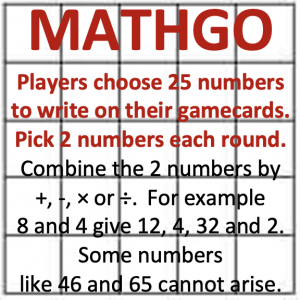Mathgo
This game is like Bingo but each player makes their own gamecard by drawing a grid and choosing 25 numbers to write on their gamecard, numbers between 0 and 100, not repeating any numbers. They cannot change the numbers once they are written on their gamecard.
 Each round the caller draws 2 cards at random from a bag, replacing the first before drawing the second.
Each round the caller draws 2 cards at random from a bag, replacing the first before drawing the second.
Players try to make some of the numbers on their board by combining the two numbers called using one of the operations +, -, × or ÷. If they succeed, they mark the numbers on their gamecard e.g. 5 and 10 make 15, 5, 50 and 2.
Everyone records the results so that the winning card can be checked.
The winner is the first player to get 5 numbers in a line and to explain how the numbers were calculated.
To make a good choice of numbers for a Mathgo gamecard, find out which numbers cannot be formed by combining two numbers from 1 to 10 and investigate how many ways each of the other numbers between 1 and 100 can arise. For example, are prime numbers a good choice to write on your card? Are larger numbers more likely to arise than smaller numbers or less likely?
In this Bingo game it is possible to make a line of 5 numbers on 5 vertical, 5 horizontal and 2 diagonal lines. When you find a number that occurs frequently it’s good strategy to put it at the centre when you set up your board.
HOLDING MATHGO: This version of the game can only be played when there is a small number of players. You can miss a turn and hold a pair of numbers in reserve until the next turn. If you hold numbers in reserve, you must use 3 numbers at the next two turns. You can combine the three numbers in any order using any of the four operations so you can make more numbers to mark on your gamecard.
Click here to download the MATHGO Notes for Teachers.
Click here to download the MATHGO worksheet
Click here for the MATHGO Inclusion and Home Learning Guide.
South Africa COVID-19 News
Here is the official website for COVID-19 updates.
Login
SUPPORT AIMSSEC






